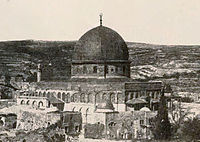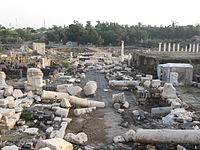holdover
.475 A&M Magnum
Early Muslim period
See also: Early Muslim conquests and Muslim conquest of the LevantRashidun period
- 637 (or 638) – Jerusalem falls to the armies of Rashidun caliph Umar Ibn el-Khatab.[89] Jews are permitted to return to the city after 568 years of Roman and Byzantine rule.[90]
- 640 – The Rashiduns capture Caesarea.[72]
- 641 – The Rashiduns capture Ashkelon, completing their conquest of the Holy Land.
- 659 – Earthquake.[91]
Umayyad period
 The Dome of the Rock (photograph from 1856)
The Dome of the Rock (photograph from 1856)- 661 – The Umayyad family takes control of the caliphate and moves its capital to Damascus, following the assassination of the Caliph Ali ibn Abi Talib.[92]
- 687–691 – The Dome of the Rock is built on the Temple Mount in Jerusalem at the site where, according to Islam, Muhammad ascended to heaven.[73]
- c. 715 – Sulayman ibn Abd al-Malik founds Ramla; it becomes the capital and administrative center of Palestine.[93]
- 744:
- February – Caliph Hisham ibn Abd al-Malik dies and is succeeded by Al-Walid II.[94]
- spring – Beginning of widespread mutinies against the Umayyads.[94]
- April – Caliph Al-Walid II is assassinated and succeeded by Yazid III.[94]
- October – Yazid III is assassinated and succeeded by Ibrahim ibn al-Walid.[94]
- November – Caliph Ibrahim is defeated in battle by Marwan II who becomes the new caliph.[94]
- 745 – Theodore is appointed patriarch of Jerusalem.[94]
- 749 January 18 – The Galilee earthquake destroys Tiberias, Scythopolis, Hippos, and Pella. Many other cities throughout the Jordan valley suffer heavy damage. Tens of thousands of lives are lost.[95][96]
 Scythopolis (Beit She'an) was one of the cities destroyed during 749 Galilee earthquake
Scythopolis (Beit She'an) was one of the cities destroyed during 749 Galilee earthquake
Abbasid period
- 747–750 – Civil war resulting in the overthrow of the Umayyads; the Abbasid family seize control of the caliphate.[97]
- 758 – The Caliph Al-Mansur visits Jerusalem and possibly orders the renovation of the Dome of the Rock.[98]
- 762 – The Abbasids found Baghdad and designate it the caliphate's new capital.[99]
- 792/3 – War between the tribes of Palestine[100]
- 796 – Battles between the tribes of Palestine.[101]
- 799 – The Patriarch of Jerusalem sends a mission to the Frankish king Charlemagne and the latter returns the favor.[102]
- c. 800 – The Jewish High Council, headed by Gaon, moves from Tiberias to Jerusalem.[103]
- 800 – The Patriarch of Jerusalem sends another mission to Charlemagne carrying the keys to the Church of the Holy Sepulchre, together with a banner.[104]
- 807 – A rebellion breaks out. Led by Abu'l-Nida', it has its epicenter in Eilat.[105]
- 813 – Earthquake.[106]
- c. 820 – The Church of the Holy Sepulchre is repaired.[107]
- 820 – Basil is appointed patriarch of Jerusalem.[108]
- 855 – Solomon is appointed patriarch of Jerusalem.[107]
- 885 – The Abbasids reconquer Damascus.[109]
- 873 – The governor of Egypt, Ahmad Ibn Tulun, breaks with the Abbasids and establishes independent rule.[109]
- 878 – The Tulunids occupy most of the former Byzantine Diocese of the East, enabling them to defend Egypt against Abbasid attacks.[110]
- 879 – Elias III is appointed patriarch of Jerusalem.[111]
- c. 881 – Elias III of Jerusalem appeals to the Franks.[112]
- c. 903 – Persian geographer Ibn al-Faqih visits Jerusalem.[113]
- 905/6 – The Abbasids regain control of Palestine.[109]
- 908/9 – Al-Muqtadir forbids Christians from serving in administrative positions.[114]
- c. 913 – Spanish scholar Ibn Abd Rabbih visits Jerusalem.[113]
- 935 – Al-Ikhshid takes control of Egypt and establishes independent rule.[109]
- 937 March 26 – Rioting Muslims burn down the Church of the Resurrection and loot the Chapel of Golgotha.[115]
- 939:
- October 17 – Muhammad ibn Ra'iq conquers Ramla.[116]
- late – Battle of al-'Arish between Ibn Ra'iq and al-Ikhshid.[116]
- 946 July – Sayf al-Dawla invades Palestine.[117]
- 966 – A Muslim-Jewish mob torches the Church of Resurrection, plunders it, and kills Jerusalem's Patriarch John VII.[118]




